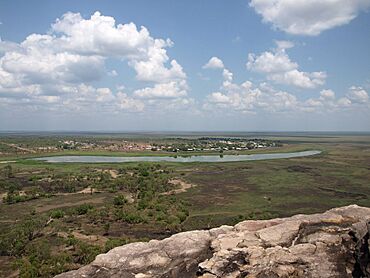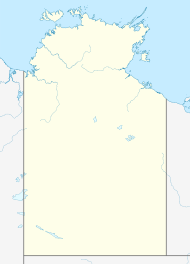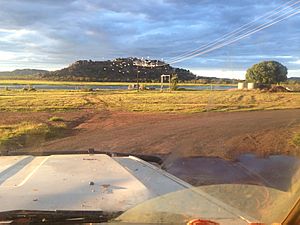Gunbalanya, Northern Territory facts for kids
Quick facts for kids GunbalanyaNorthern Territory |
|
|---|---|

A view of Gunbalanya from nearby Injalak Hill
|
|
| Location | 300 km (186 mi) east of Darwin |
| LGA(s) | West Arnhem Region |
| Region | Arnhem Land |
| Territory electorate(s) | Arafura |
| Federal Division(s) | Lingiari |
Gunbalanya (also known as Kunbarlanja) is a special Aboriginal Australian town. It is located in west Arnhem Land in the Northern Territory of Australia. The town is about 300 kilometers (186 miles) east of Darwin.
The main language spoken here is Kunwinjku. This is a dialect of Bininj Kunwok. In 2021, about 1,177 people lived in Gunbalanya.
You can only reach Gunbalanya by air during the wet season. The town is famous for its Aboriginal art. This includes amazing rock art and bark painting. Gunbalanya has many services. These include a police station, a school, and a community arts center called Injalak Arts.
It is also the closest town to Awunbarna. This place is also known as Mount Borradaile. It is a very important Aboriginal sacred site with lots of ancient Indigenous Australian rock art.
Contents
Discovering Gunbalanya's Past
The area we now call Gunbalanya was first named "Uwunbarlany". This name was given by the Erre-speaking people. They were the first people to live here.
Later, a man named Paddy Cahill started a cattle station in 1909. He pronounced the local word as "Oenpelli". This became the town's old name. The name "Gunbalanya" comes from the word Kunbarlanja. This is how people speak it in the Kunwinjku language today. People who speak Kunwinjku started moving to the area after Cahill's cattle station began.
The Mission Years
In 1925, a mission was set up in Oenpelli. The Church of England's Church Missionary Society started it. Reverend Alfred Dyer and his wife Mary ran the mission. They built a church, a school, a health clinic, a garden, and a store. They also worked with wild cattle and horses.
Many people attended the mission school. One famous student was Big Bill Neidjie. He was a respected elder and shared his culture.
Narlim was the eldest son of the land's traditional owner. He was born in 1909 and grew up at the mission. He stayed there because he wanted his children to learn English. He also saw it as a way to stay on Country. This means staying on their traditional land.
In 1933, a young woman named Nell Harris learned the Kunwinjku language. She worked with Hannah Mangiru and Rachel Maralngurra. Together, they translated parts of the Gospel of Mark into Kunwinjku.
Oenpelli was a mission until 1975. Then, an Aboriginal town council took over. The town's name was changed to Gunbalanya.
Exploring the Land and Art
In 1948, a group of scientists visited Oenpelli. They were part of the 1948 American-Australian Scientific Expedition to Arnhem Land. They spent three months collecting local art and items.
The leader, Charles Mountford, returned in 1949. He found amazing cave paintings at a place called Obiri. This shelter was 18 meters (59 feet) long and 2.7 meters (9 feet) high. It had thousands of figures painted on its walls. Mountford thought this site should become a national reserve.
Names from the Past
The old name "Oenpelli" is still used for some things.
- A large and rare python is called the Oenpelli python (Morelia oenpelliensis).
- A type of tree is called Oenpelli bloodwood (Corymbia dunlopiana).
- A geological event from long ago is known as the Oenpelli Dolerite event. This happened about 1,720 million years ago.
People and the Surrounding Area
Most people in Gunbalanya speak Kunwinjku. They are part of the Bininj peoples. In 2016, the town had 1,116 people. About 88.6% of them were Aboriginal and/or Torres Strait Islander.
Gunbalanya is the biggest town in its area. It is close to Awunbarna, also known as Mount Borradaile. This mountain is about 120 meters (394 feet) high. It is about 34.9 kilometers (21.7 miles) away. Awunbarna is a sacred site. It has many important rock paintings.
A study in 2020 found paintings at 87 sites in western Arnhem Land. These are called the Maliwawa Figures. They stretch from Awunbarna west to the Wellington Range.
Getting There and What to Find
The Arnhem Highway connects Darwin to Jabiru. Jabiru is a town inside Kakadu National Park. About 4 kilometers (2.5 miles) before Jabiru, a road turns off. This road goes to Ubirr, the Border Store, and Cahill's Crossing. Cahill's Crossing is on the East Alligator River.
The road is dirt from the East Alligator River to Gunbalanya. This is about 16 kilometers (10 miles). You can usually drive this road with a four-wheel drive car. However, the river crossing is a causeway. It closes when there are floods during the wet season (November to April). It also closes at high tides.
During the dry season, you can drive from Darwin to Gunbalanya in about three hours. It takes less than an hour from Jabiru. You need special permits from the Northern Land Council to cross the East Alligator River. This river is the western border of Arnhem Land. You can get permits from offices in Darwin or Jabiru. It can take up to two weeks to get them. Many visitors choose to go with an organized tour.
Oenpelli Airport is a sealed airstrip in Gunbalanya. It can be used in all weather. Several companies offer charter flights to and from this airport.
Gunbalanya is a major Aboriginal town in Arnhem Land. It has many facilities:
- A school (from pre-school to Year 12)
- A health clinic
- A service station
- A police station
- Aged care services
- Recreational clubs
- The Injalak Arts community center
- Various stores
The Stone Country Festival is usually held in August. You do not need a permit to attend this event. It is an annual event, but sometimes it cannot be organized.
The local radio station is called "RIBS". This stands for Remote Indigenous Broadcasting Service.
Amazing Indigenous Art
Western Arnhem Land has some of the most important rock art in the world.
Rock Art
Local art traditions are still strong today. The Injalak Arts Centre helps keep them alive. Injalak Arts is named after Injalak Hill. This nearby hill has many rock art galleries. It is the main place tourists visit in Gunbalanya.
Bark Painting
In the 1960s, the mission at Oenpelli encouraged artists. They asked traditional rock painting artists to paint on bark. These painted barks were sold to scientists and travelers. This became a small local industry.
Many important Aboriginal artists started painting on bark. These included Lofty Bardayal, Mick Kubarrku, and Dick Murramurra. Their bark paintings are now in art galleries around Australia and the world. Some famous exhibitions include "Old Masters" at the National Museum of Australia. Another is "Crossing Country" at the Art Gallery of New South Wales.
Gunbalanya in Film
Parts of the 2020 film High Ground were filmed in this area. The movie tells a story that reflects some of the region's history.
In the Anime film "Mobile Suit Gundam Hathaway", the town is a meeting point. A group of "rebel" supporters gathers there. Over 30,000 supporters of the "Mafty" group met in the town. In the film, the town's name is spelled "Oenbelli". This is due to a computer error during the town's registration in the space travel era.
|
See also
 In Spanish: Gunbalanya para niños
In Spanish: Gunbalanya para niños




